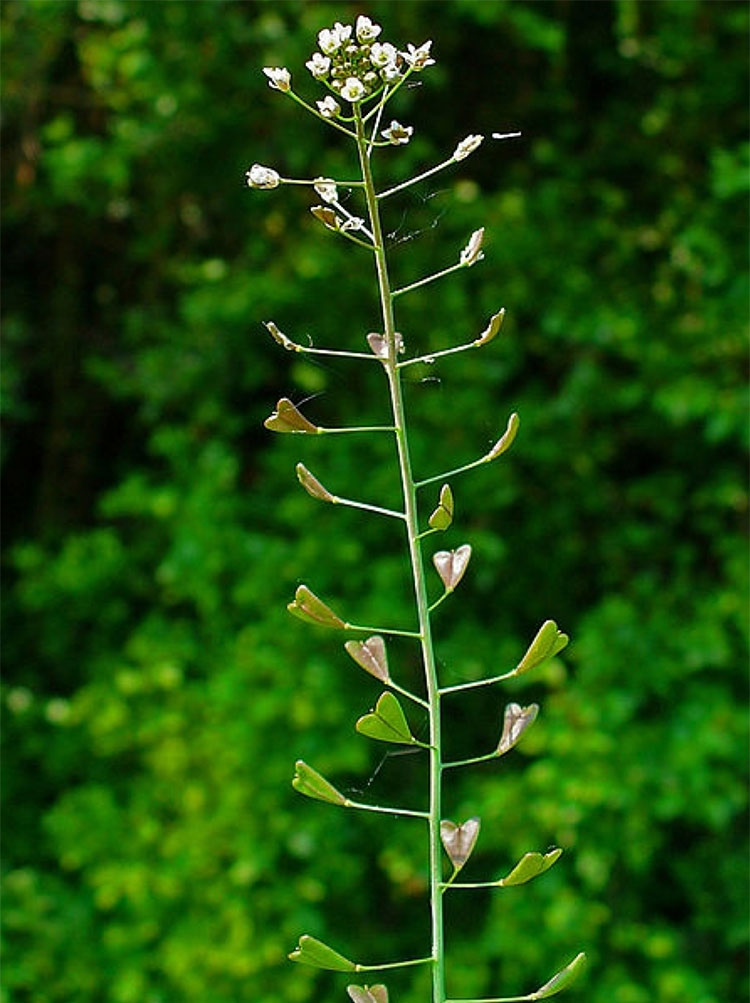Shepherd’s Purse
Capsella bursa-pastoris is a European native that frequents nature's back alleys — fence lines, roadsides, neglected gardens — anywhere you forget to mow.
Scientific Name: Capsella bursa-pastoris
Common Name: Shepherd's Purse
Plant Family: Brassicaceae (Mustard Family)
Etymology: Capsella bursa-pastoris comes from the Latin words for box, capsa, and purse, bursa. Pastorsis refers to pastoral, or shepherding, and when put together, bursa-pastoris means shepherd's purse, which refers to the purse-like shape of the plant's seed pods.
Indigenous Uses
Native American use of shepherd's purse was both as drug and food. The Ojibwe, Costanoan, and Mahuna tribes boiled the whole plant to make a remedy for dysentery and diarrhea. The Mohegan tribe used the seedpods to treat stomach pains and as a deworming method. The seeds were ground for flour or roasted whole in tribes such as the Apache, Chiricahua, and Mescalero. Other tribes used leaves as greens or cooked them as parts of other dishes.
Edible Parts
The seeds of the shepherd's purse can be ground into flour or roasted whole. Seeds can also be used in soups and stews. The leaves can be cooked and added to dishes or be eaten raw as greens. Dried leaves can be used in teas. Roots can be used as an alternative to ginger when fresh or dried.
Gathering and Using
Leaves should be gathered before flowering (winter/spring) for best taste. Peppery flavor develops with age. Leaves should be collected in the summer to be dried. Dried leaves should be used within a year of drying.
Permaculture Functions and Considerations
Uses as food and drug make the shepherd's purse a valuable permaculture plant.
Habitat
As a common weed, shepherd's purse can grow almost anywhere with decent sun exposure. It is often found in unkept areas and will easily spread throughout the area.
 Zell, H. “Gewöhnliches Hirtentäschel (Capsella Bursa-Pastoris).” Gewöhnliches Hirtentäschel,
2009. Accessed 15 Feb. 2023.
Zell, H. “Gewöhnliches Hirtentäschel (Capsella Bursa-Pastoris).” Gewöhnliches Hirtentäschel,
2009. Accessed 15 Feb. 2023.
How to Identify
Shepherd's purse can be recognized by its distinct seed pods, tiny four-part white flowers, and serrated basal leaves. Its flat, heart-shaped seed pods stick off of the stem and line the top portion of the stem. Its basal leaves are similar to those of a dandelion: long, serrated, and fuzzy on the underside. The flowers are white and tiny, usually not more than a quarter inch in width. The flower is encased by four fuzzy sepals that pinken with age, and the flower itself is four white petals that surround six yellow stamen around a single pistil.
Sources
- “Capsella Bursa-Pastoris - (L.)Medik.” Pfaf Plant Search.
- “Capsella Bursa-Pastoris (L.) Medik.” USDA Plants Database.
- Moerman, Daniel E. “Capsella, Brassicaceae.” Native American Ethnobotany, Timber Press, Portland, Oregon, 2016, p. 136.
- “Shepherd's Purse, Capsella Bursa-Pastoris (L.) Medik.” The Friends of the Wild Flower Garden, Inc.
- Zell, H. “Gewöhnliches Hirtentäschel (Capsella Bursa-Pastoris).” Gewöhnliches Hirtentäschel, 2009.